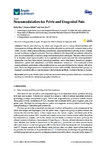Neuromodulation for Pelvic and Urogenital Pain
| dc.contributor.author | Roy, Holly | |
| dc.contributor.author | Offiah, I | |
| dc.contributor.author | Dua, A | |
| dc.date.accessioned | 2021-11-12T13:01:22Z | |
| dc.date.issued | 2018-09-29 | |
| dc.identifier.issn | 2076-3425 | |
| dc.identifier.issn | 2076-3425 | |
| dc.identifier.other | ARTN 180 | |
| dc.identifier.uri | http://hdl.handle.net/10026.1/18342 | |
| dc.description.abstract |
Chronic pain affecting the pelvic and urogenital area is a major clinical problem with heterogeneous etiology, affecting both male and female patients and severely compromising quality of life. In cases where pharmacotherapy is ineffective, neuromodulation is proving to be a potential avenue to enhance analgesic outcomes. However, clinicians who frequently see patients with pelvic pain are not traditionally trained in a range of neuromodulation techniques. The aim of this overview is to describe major types of pelvic and urogenital pain syndromes and the neuromodulation approaches that have been trialed, including peripheral nerve stimulation, dorsal root ganglion stimulation, spinal cord stimulation, and brain stimulation techniques. Our conclusion is that neuromodulation, particularly of the peripheral nerves, may provide benefits for patients with pelvic pain. However, larger prospective randomized studies with carefully selected patient groups are required to establish efficacy and determine which patients are likely to achieve the best outcomes. | |
| dc.format.extent | 180-180 | |
| dc.format.medium | Electronic | |
| dc.language | en | |
| dc.language.iso | en | |
| dc.publisher | MDPI | |
| dc.subject | pelvic pain | |
| dc.subject | bladder-pain syndrome | |
| dc.subject | neuromodulation | |
| dc.subject | posterior tibial-nerve stimulation | |
| dc.subject | sacral-nerve stimulation | |
| dc.subject | dorsal-root-ganglion stimulation | |
| dc.title | Neuromodulation for Pelvic and Urogenital Pain | |
| dc.type | journal-article | |
| dc.type | Journal Article | |
| dc.type | Review | |
| plymouth.author-url | https://www.webofscience.com/api/gateway?GWVersion=2&SrcApp=PARTNER_APP&SrcAuth=LinksAMR&KeyUT=WOS:000448655700003&DestLinkType=FullRecord&DestApp=ALL_WOS&UsrCustomerID=11bb513d99f797142bcfeffcc58ea008 | |
| plymouth.issue | 10 | |
| plymouth.volume | 8 | |
| plymouth.publication-status | Published online | |
| plymouth.journal | Brain Sciences | |
| dc.identifier.doi | 10.3390/brainsci8100180 | |
| plymouth.organisational-group | /Plymouth | |
| plymouth.organisational-group | /Plymouth/Faculty of Health | |
| plymouth.organisational-group | /Plymouth/Faculty of Health/Peninsula Medical School | |
| plymouth.organisational-group | /Plymouth/REF 2021 Researchers by UoA | |
| plymouth.organisational-group | /Plymouth/REF 2021 Researchers by UoA/UoA01 Clinical Medicine | |
| plymouth.organisational-group | /Plymouth/Research Groups | |
| plymouth.organisational-group | /Plymouth/Research Groups/FoH - Applied Parkinson's Research | |
| plymouth.organisational-group | /Plymouth/Users by role | |
| plymouth.organisational-group | /Plymouth/Users by role/Academics | |
| plymouth.organisational-group | /Plymouth/Users by role/Researchers in ResearchFish submission | |
| dc.publisher.place | Switzerland | |
| dcterms.dateAccepted | 2018-09-28 | |
| dc.rights.embargodate | 2021-11-13 | |
| dc.identifier.eissn | 2076-3425 | |
| dc.rights.embargoperiod | Not known | |
| rioxxterms.versionofrecord | 10.3390/brainsci8100180 | |
| rioxxterms.licenseref.uri | http://www.rioxx.net/licenses/all-rights-reserved | |
| rioxxterms.licenseref.startdate | 2018-09-29 | |
| rioxxterms.type | Journal Article/Review |


